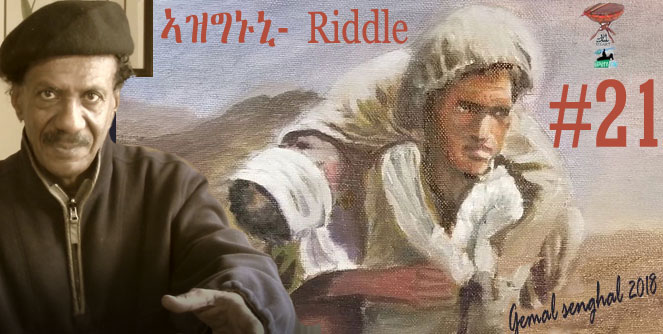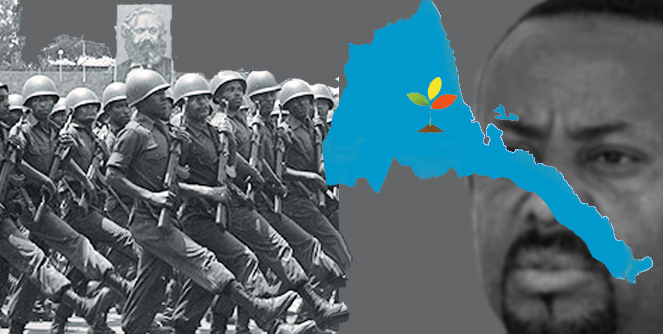Negarit #21- Riddle — ኣዝግኑኒ
Reading time 5 minutes
A family. A microcosm of an Eritrean family. Love, hope, and despair. Weddings, childbirths, and death… and burial services. This family is so used to the last one, living on the foothill of Qatsetai, whose top was a Christian orthodox burial ground. It is a place where priests in full regalia, garbs, and bells led the solemn crowds who carried the coffin. A Wata playing a sad, melancholic tune walked alone behind them. Women wailing or sobbing, and chocking in tears walked behind them.
Across the street, a little up the hill was a Muslim graveyard. Usually, an elderly man led the procession murmuring prayers for the dead. And crowds followed, carrying the body of the deceased on a stretcher, covered in a white blanket.
The family watched such common scenes on a regular basis. So did the youth of the neighborhood. Among them were Saleh Adem Idris (Keray), Ibrahim Kerami, and Mehari Berakhi. Saeed Saleh was their leader whom they watched in awe.
The three worked hard for years to grow up. They lifted rocks for weights in an improvised alley-Gym, and checked their muscles every now and then, hoping they would buff up their bodies soon. Saeed Saleh would click a cigarette lighter pretending it was a camera flash while the rest took off their shirts and displayed their muscles like confident bodybuilders. In time, Saeed Saleh thought he had buffed his muscles enough–one day he vanished. His body-building friends didn’t discover his mysterious disappearance for almost a year. Then they found out he had joined Jebhat, the Eritrean rebel group known as Jebhet Tahreer, Eritrean Liberation Front. Soon, the three followed in his footsteps and joined the ranks of the ELF.
That is the story of one of the three: the martyr Saleh Adem Idris Keray
In the late 1970s, Saleh Keray ended up a senior in a battalion commanded by his friend Said Saleh.
In 1977 Saleh Keray sneaked into Keren and visited his family. It was the last time his young siblings saw him. On September 8, 1980, he died in Hawashait of a wound he sustained in Kerkebet, in a joint EPLF-TPLF assault on the ELF. Three years later Saeed Saleh, his friend, and commander, was mysteriously assassinated in Kassala. To date, though there are several suspects, the culprits who assassinated him are not yet identified.
In 1982, Saleh Keray’s father, Shiekh Adem Idris died. In 1995, his mother Seedia died. In 1999, Abdulkadir lost his life in the Ethiopian-Eritrean border war. He is the man in the iconic picture of today.
In 1992 the PFDJ issued martyrdom-certificates for combatants killed in action. They also distributed “compensation money” to families whose children died in the struggle. Officers arrived at the home of Shiekh Adem Idris, the father of martyr Saleh Keray andy met his wife Sa’diya. Her full name is Sa’ediya Adem Mohammed Ali Reka Gebrekristos Ashad Gergish Shum-Redie. They offered her 5000 Nakfa as a compensation since she was the only surviving parent of Saleh Keray. They also wanted to give her another 5000 Nakfa to recieve on behalf of Said Saleh’s deceased parents. The lady was not only a close neighbor of Shaikh Saeed Saleh’s parents, but she has watched him grow up like her own son. She refused to accept her sons “compensation money” and that of Saeed Saleh.
The wounded mother explained why she refused the money. She said, “I know that an enemy bullet hit my son Saleh in Kerkebet. But unknown people assassinated Saeed Saleh. I will not accept blood money, neither for my son’s blood nor for Saeed Saleh’s—first, you should tell me who his killers are.” She also said, “I will not betray Saeed’s parents who died without knowing who killed their son. And I cannot disrespect them by accepting blood money when they are dead and buried. And I will not receive blood money for the two of them”
They returned with the money, the 10,000 Nakfa they brought.
Saleh’s young brother Abdulkadir (the iconic picture), and his siblings were there. They listened to the conversation
One of Abdulkadir’s siblings in the house is Ferejet Adem Idris, who joined the armed struggle in 1976. She was in a battalion under the command of the late General Grezgher Wuchu and later sustained a wound in a battle around Himberti. Until the independence of Eritrea, Ferejet worked in the medical division. During the Ethiopia Eritrean border war, she served in fronts of Zalambessa and Badme. She finally settled in the Glass hospital. Ferejet is still serving within the medical teams of the war veterans.
Abdulkadir Idris is the third sibling who joined the national army. He is the man in the iconic picture carrying his wounded colleague.
Abdulkadir was born in 1970 in the Hashela neighborhood in Keren. Later on, he moved with his family to Sudan and went to school there. He briefly joined the United Front and then returned to Kessela where he stayed until the independence of Eritrea when he returned home to Keren. In 1997 he joined the seventh round of Sawa. When the border war started, he joined a unit in the 381 tank division and shipped to the war front. On February 17, 1999, an unknown photographer shot the iconic picture–it’s of him carrying a wounded colleague, Hamid Saleh Hummed (nicknamed Saddam).
Saddam sustained many wounds in a landmine blast but survived his wounds. He is now alive and flourishing as a farmer and merchant in the town of Tessenei.
Six days after the shooting of the picture, on February 17, 1999, a nighttime air raid hit a tank in Adi Qeshi. Inside it sat Abdulkadir and Teame, his tank squad commander. They were both killed inside it. Two of their colleagues, Wedi Berhe and Sendel, escaped with wounds as they stood close by.
Hamid Saddam has returned by renting a car to get to the war front from Barentu where he was seeing a dentist. Three days later he was wounded and taken to safety by Abdulkadir, a few days later and Abdulkadir was killed.
There are such human stories behind any picture we see, and behind any name of a martyr we hear.



Awate Forum